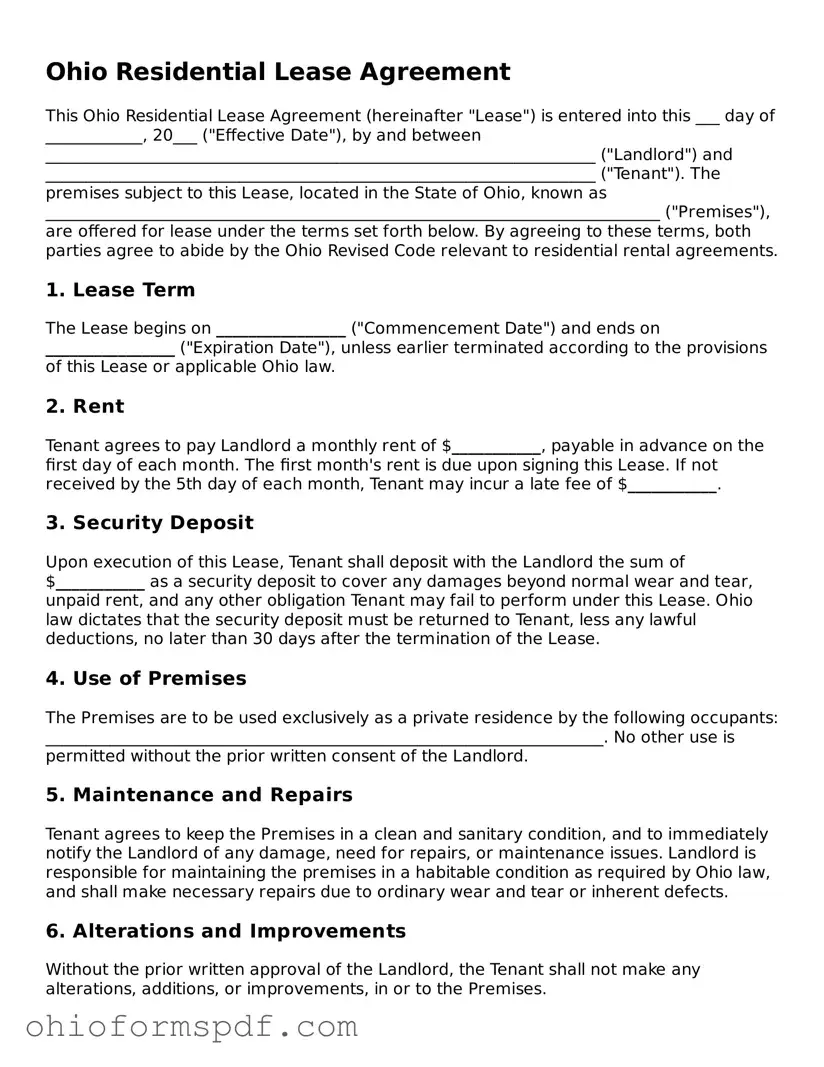Ohio Residential Lease Agreement
This Ohio Residential Lease Agreement (hereinafter "Lease") is entered into this ___ day of ____________, 20___ ("Effective Date"), by and between ____________________________________________________________________ ("Landlord") and ____________________________________________________________________ ("Tenant"). The premises subject to this Lease, located in the State of Ohio, known as ____________________________________________________________________________ ("Premises"), are offered for lease under the terms set forth below. By agreeing to these terms, both parties agree to abide by the Ohio Revised Code relevant to residential rental agreements.
1. Lease Term
The Lease begins on ________________ ("Commencement Date") and ends on ________________ ("Expiration Date"), unless earlier terminated according to the provisions of this Lease or applicable Ohio law.
2. Rent
Tenant agrees to pay Landlord a monthly rent of $___________, payable in advance on the first day of each month. The first month's rent is due upon signing this Lease. If not received by the 5th day of each month, Tenant may incur a late fee of $___________.
3. Security Deposit
Upon execution of this Lease, Tenant shall deposit with the Landlord the sum of $___________ as a security deposit to cover any damages beyond normal wear and tear, unpaid rent, and any other obligation Tenant may fail to perform under this Lease. Ohio law dictates that the security deposit must be returned to Tenant, less any lawful deductions, no later than 30 days after the termination of the Lease.
4. Use of Premises
The Premises are to be used exclusively as a private residence by the following occupants: _____________________________________________________________________. No other use is permitted without the prior written consent of the Landlord.
5. Maintenance and Repairs
Tenant agrees to keep the Premises in a clean and sanitary condition, and to immediately notify the Landlord of any damage, need for repairs, or maintenance issues. Landlord is responsible for maintaining the premises in a habitable condition as required by Ohio law, and shall make necessary repairs due to ordinary wear and tear or inherent defects.
6. Alterations and Improvements
Without the prior written approval of the Landlord, the Tenant shall not make any alterations, additions, or improvements, in or to the Premises.
7. Governing Law
This Lease shall be governed, construed, and enforced in accordance with the laws of the State of Ohio, without regard to its conflict of laws principles.
8. Entire Agreement
This Lease constitutes the entire agreement between the parties and supersedes all previous discussions, promises, or agreements. Amendments to this Lease must be in writing and signed by both parties.
Signatures
IN WITNESS WHEREOF, the parties have executed this Lease as of the Effective Date first above written.
Landlord's Signature: _____________________________________ Date: ____________
Tenant's Signature: _____________________________________ Date: ____________
